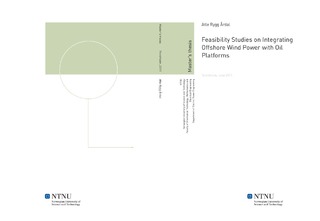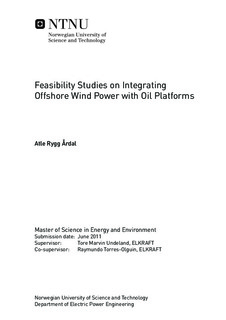| dc.contributor.advisor | Undeland, Tore Marvin | nb_NO |
| dc.contributor.advisor | Torres-Olguin, Raymundo | nb_NO |
| dc.contributor.author | Årdal, Atle Rygg | nb_NO |
| dc.date.accessioned | 2014-12-19T13:52:44Z | |
| dc.date.available | 2014-12-19T13:52:44Z | |
| dc.date.created | 2011-09-19 | nb_NO |
| dc.date.issued | 2011 | nb_NO |
| dc.identifier | 441752 | nb_NO |
| dc.identifier | ntnudaim:6101 | nb_NO |
| dc.identifier.uri | http://hdl.handle.net/11250/257082 | |
| dc.description.abstract | This thesis is centered around the possibilities of integrating offshore wind power together with oil and gas platforms. The motivation behind this topic is to reduce the emissions of CO2 and other pollutive gases from conventional offshore power plants. The electrical systems on oil platforms are weaker than an onshore grid, so measures should be taken to let the wind power integration contribute to a more stable operation on the platform. To explore existing and future technologies that can achieve this is an important part of this work. Two different power systems are presented, denoted System 1 and System 2. Their schematics are shown in Fig. 1. Corresponding simulation models are built from fundamental blocks in the software PSCAD/EMTDC. Aggregated models are utilized in order to save computational time.System 1 consists of an offshore wind farm and an oil platform connected together in islanded operation. The oil platform contains an synchronous generator with an associated gas turbine and can adjust both active and reactive power quickly. The load consists of fixed-speed induction motors. The wind farm contains a back-to-back Voltage Source Converter (VSC) which is used for variable speed operation of the turbine. The converter is also used for voltage support to the system, and this functionality reduces voltage oscillations during disturbances. The most critical scenario investigated is to start a large induction motor. It is shown that the transmission cable may contribute to an increasing risk of voltage collapse during the start-up. Another critical event is when the wind power is suddenly disconnected, and the gas turbine has to adjust the power output quickly in order to avoid too large frequency deviations. The simulations show that a disconnection of the whole wind farm does not lead to critical operation or possible instability. This would not be the case in a system with slower control systems in the gas turbine and synchronous generator.System 2 consists of a VSC-HVDC connection between Kollsnes and the platform Troll A. This existing configuration is powering a gas compressor on the platform through a variable speed synchronous motor. This thesis proposes to integrate wind power on the DC-side of the Troll A VSC-terminal. The challenge is to inject wind power in a way such that the operation of the gas compressor is not disturbed. The proposed control system is working as intended, and the selected simulation cases show that the compressor system is not affected by the wind power. The DC voltage control system is able to maintain a constant voltage at the Troll terminal during normal operation. The wind farm reduces the losses in the HVDC-cable, and surplus wind power is sent to the land grid during low-load operation. The DC-voltage drops to 73 % of the rated value for 10 ms when the wind power is suddenly disconnected, but the duration is so short that it does not affect the gas compressor operation.The simulation results indicate that both configurations are feasible. However, the results are heavily dependent on the parameter data, and further research should put more efforts into gaining as correct values as possible. A sensitivity analysis is performed to System 1 as a guideline to which parameters that are most decisive, and therefore should be modeled most accurately. In addition, new simulation cases might reveal challenges that this thesis does not concern. | nb_NO |
| dc.language | eng | nb_NO |
| dc.publisher | Institutt for elkraftteknikk | nb_NO |
| dc.subject | ntnudaim:6101 | no_NO |
| dc.subject | MTENERG energi og miljø | no_NO |
| dc.subject | Elektrisk energiteknikk | no_NO |
| dc.title | Feasibility Studies on Integrating Offshore Wind Power with Oil Platforms | nb_NO |
| dc.type | Master thesis | nb_NO |
| dc.source.pagenumber | 128 | nb_NO |
| dc.contributor.department | Norges teknisk-naturvitenskapelige universitet, Fakultet for informasjonsteknologi, matematikk og elektroteknikk, Institutt for elkraftteknikk | nb_NO |

